A Series of Missteps That Kept Staples Swimming in Chaos for Years
Industry-leading incumbents are often disrupted by younger, smaller start-ups and fail to adapt to new competitive dynamics. As the leaders in the office supply segment, Staples offers an example of an incumbent that departed from its successful strategy and failed in its effort to shape a new coherent strategic vision.
Staples Pre-2007: A Leading Office Supply Retailer
Staples was founded by Leo Kahn and Thomas G. Stemberg, who were former rivals in the New England retail supermarket industry. The first store was opened in the Brighton neighborhood of Boston in 1986.
In contrast to its competitors, when the Federal Trade Commission (FTC) review was launched, Staples continued to grow rapidly. The company opened 170 new stores in 1996 and 1997. As the store network grew into a nationwide footprint, Staples began to shift its strategy—from EDLP (Everyday low price) value to more emphasis on widest range, as signaled by its new slogan “Yeah, We’ve Got That.”
Staples added new categories; expanded services, especially print and copy; and shifted emphasis from small business to the home, school, and home-office segment. Staples redesigned their stores and renewed investment in information technology and the supply chain to drive greater productivity. Staples itself was becoming a retail company with substantial brand equity.
Despite the tech crash in 2000 and the 2001 recession, Staples continued its growth. Sales in 2002 were $11.6 billion, and the network topped 1,300 stores. The launch of staples.com in 1998 had been slow to build momentum, but by 2002 the online channel was transforming the North American commercial delivery and contract segment.
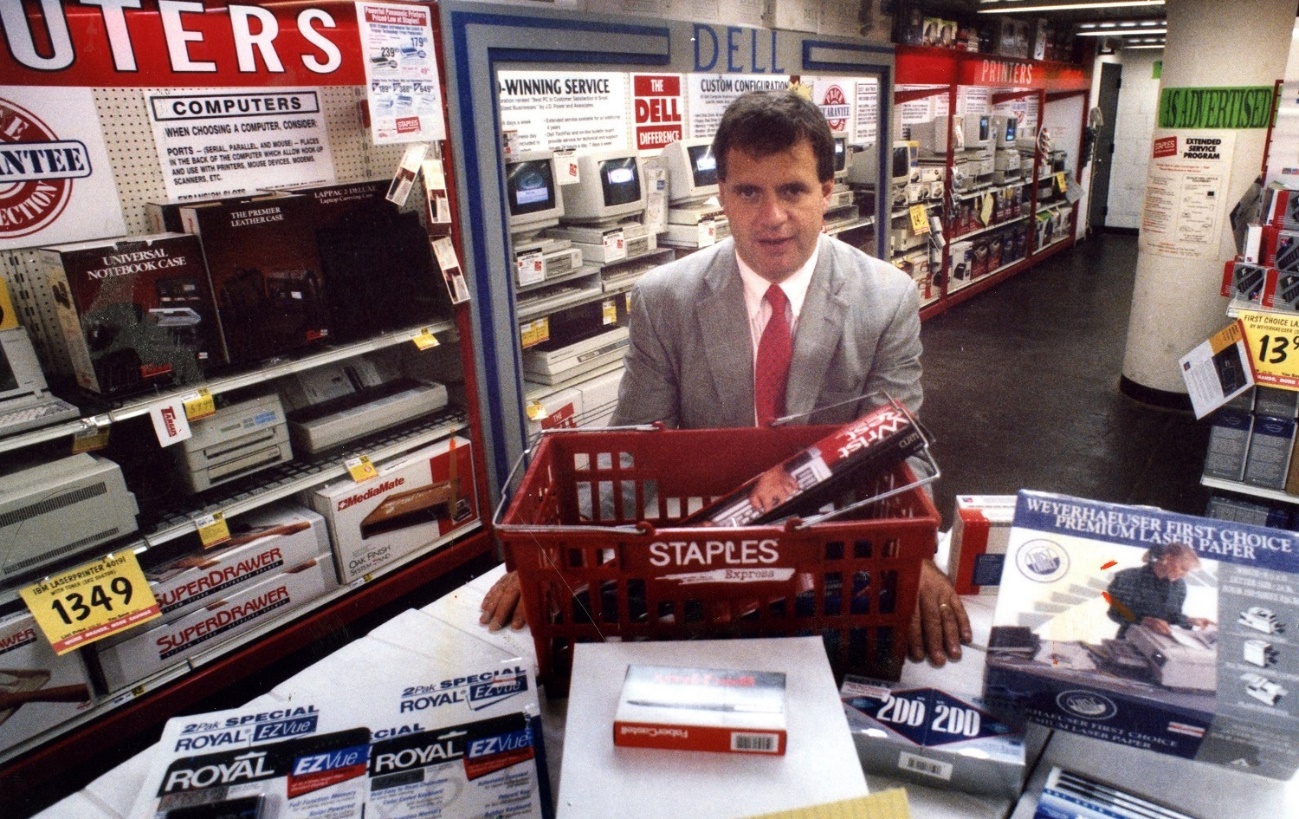
Staples also saw its first leadership change in 2002, as Tom Stemberg stepped down and was replaced by Ron Sargent as chief executive. Sargent began to shift Staples’ strategy from rapid growth toward greater efficiency and profitability. Sargent’s plan had four pillars: serve the small-business customer, drive profitable sales, improve operating margins, and increase asset productivity. This reorientation led to fewer store openings and a shift toward renovations and refurbishments. By 2007, Staples had shifted from an EDLP value retailer to a hi-low promotional business, reinforced by a loyalty program (Staples Rewards).
By the beginning of the U.S. economic recession in 2007–2008, Staples had extended its position as the leading office-supply retailer. Staples also had much higher profitability and productivity. Staples’ 5.1% return on sales was twice that of Office Depot and OfficeMax. As a consequence, Staples’ market capitalization of $15.3 billion was four times greater than that of Office Depot and 10 times greater than that of OfficeMax.
Reversal of Fortunes: Staples’ Series of Failing Strategies
Staples then embarked on a series of major strategic decisions that had dramatic negative consequences for the company. Staples had made minor forays into international markets with European, Chinese, and Indian operations. But faced with a softening U.S. economy in late 2007, senior management sought to expand Staples’ international presence as rapidly as possible.
#1. ‘One Size Fits All’ Didn’t Always Work
In February 2008, the company launched an unsolicited bid for Corporate Express, one of the world’s largest office-product wholesalers. Including the debt financing of the deal, Staples’ total debt went from $350 million in 2007 to more than $4 billion by November 2008, with $2.94 billion of that amount due for payment or refinancing within a year. With the global financial crisis exploding in September 2008, Staples’ debt-financed deal came at the worst possible time.
The 2008–2011 period proved to be tough going. Because of the U.S. recession, North American revenues essentially were flat. Staples’ international businesses lost almost a half billion dollars in revenues and saw a reversal from profits to significant losses. Staples also slowed store openings and shifted its strategy from reinvesting in the business to distributing operating cash flow to shareholders through dividends and share repurchases.
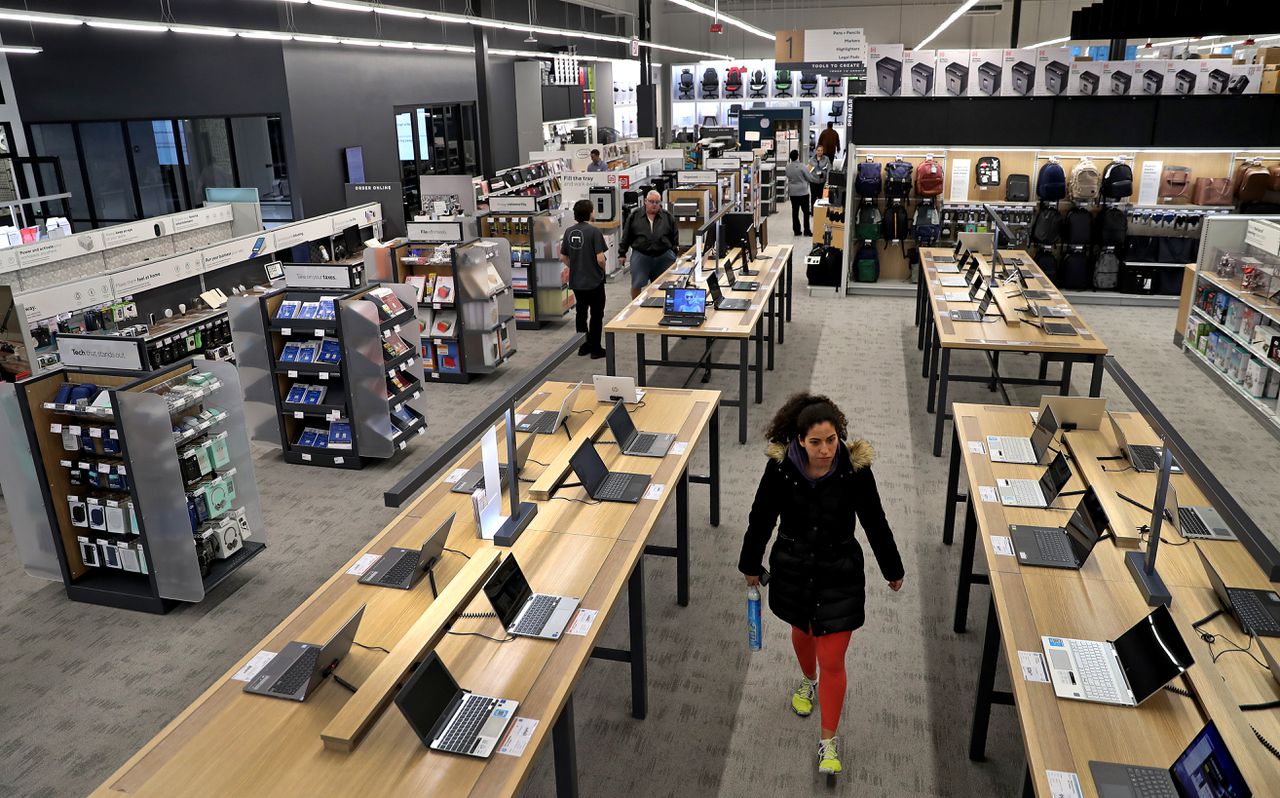
In the wake of this weak performance, Staples announced an aggressive cost-cutting program. The company also announced a dramatic shift in its merchandise strategy away from office supplies toward general merchandise, under the tag line “Every product your business needs to succeed.”
The cover of Staples’ 2012 annual report showed an array of products, including hammers, stethoscopes, drills, vaporizers, and kitchen blenders. Both the online business and the stores dramatically reduced both width and depth of their traditional office-supply categories, spurring declines in customer-satisfaction scores without offsetting new business.
By 2014, Staples’ attempt to reinvent the company with a general merchandising strategy was failing. More than 469 stores were closed, and revenues had fallen by $2 billion since 2012. Return on sales was only 0.6%. The shift in merchandise strategy was not matched by investment in the business—dividends and repurchases were 50 percent greater than capital expenditures. Staples had clearly decided that its future was no longer in stores, and no longer in office supplies.
#2. M&A Flop: Merging Two Failing Companies to Make A Successful One?
However, Staples’ “reinvention” was completely turned upside down with the announcement in February 2015 that the company proposed to buy Office Depot for $6.3 billion, a 44 percent premium to Office Depot’s prior closing price, and a 65 percent premium over the average price in the prior quarter. (Acquisition premiums typically average 20 to 30 percent.)
It is near-impossible to understand why Staples was interested in acquiring Office Depot. Both Office Depot and OfficeMax were struggling during the financial crisis and recession, losing share to Staples, and undergoing repeated restructurings and management changes. Office Depot’s stock price had fallen from $39 per share in 2007 to $3 per share in 2013; OfficeMax fell from $55 per share to $7 per share over the same period. Weak performance was exacerbated by weak balance sheets.
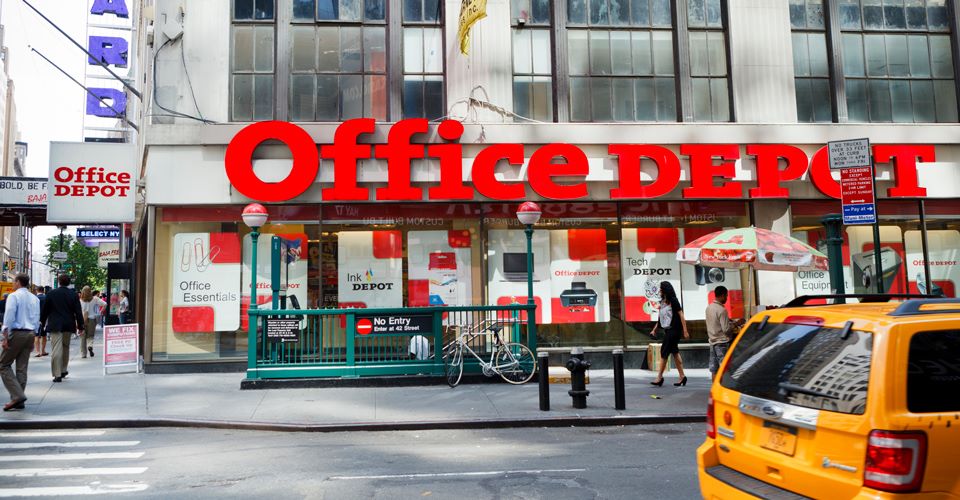
The deal was completed with the hope of creating a combined company of 2,200 stores, with revenues of $17 billion. But merger integration proved to be a challenge, with cost savings being swamped by restructuring costs and the closing of 400 stores. Conflicts arose over who would be the CEO, where combined headquarters would be located, and what the name of the combined company would be (the name they settled on was Office Depot Office Max!). A year after the deal, combined revenues were down to $16.1 billion with a net loss of $312 million. An additional 300 stores were slated for closure.
Given this bleak performance and outlook, it’s hard to understand why Staples wanted to acquire Office Depot, let alone why they offered such a huge buyout premium. Even Ron Sargent, Staples’ CEO, seemed confused in his letter to shareholders in the 2014 annual report, writing:
“The progress on our strategic reinvention is a result of the strength, experience, and persistence of Staples’ management team and board of directors. We’re responding to the changing needs of customers, aggressively reducing expenses, and competing with a much wider set of competitors in categories beyond office supplies. While we’re right on track with our reinvention, we also remain committed to carefully considering other strategic options.
In early 2015, we announced the acquisition of Office Depot. We believe that the acquisition will create significant value for our shareholders and our customers. It will better position us to accelerate our reinvention and more effectively compete with a wide range of competitors in a range of categories beyond office supplies.”
#3. Hit from The Outside: Antitrust Policy
The situation got even more chaotic when the U.S. Federal Trade Commission sought to block the deal, citing “antitrust” concerns that the merger would give too much power to the combined company in the market for commercial office supplies. After many delays and extensions, the case moved to trial in late 2015. The markets became increasingly pessimistic that the proposed deal would be completed; Office Depot began to trade well below the bid price. Moreover, the core businesses continued to erode. In early 2016, Staples reported that 2015 revenues were down $1.4 billion from 2014, while Office Depot reported revenues of $14.5 billion, down $1.6 billion from a year earlier.
Faced with faltering businesses and a premium-priced deal, Staples then stunned the investment community when it chose not to present any defense of the proposed merger to the court, saying the government’s case was woefully lacking and a defense was unnecessary. On May 10, 2016, the judge then upheld the government blocking of the deal, noting his surprise at Staples’ unwillingness to provide any justification.
Cynical commentators believed that Staples was trying to get out of the deal, but in any case, it proved extremely costly. After the court decision, the combined market capitalization of Staples and Office Depot by mid-2016 was half of that of Staples alone in 2007. Staples had to pay Office Depot a $250 million breakup fee and announced it would proceed with more cost cuts. Three weeks later, Ron Sargent resigned after 26 years with the company and 15 as CEO.
The Cost of Miscalculation: Staples Is No Longer A Public Company
Since late 2017, Staples is no longer a public company. It was acquired by private equity firm Sycamore Partners for $6.9 billion – a deal that would dramatically restructure the struggling office supply retailer. Staples’s board and management decided to sell the company after shareholders had essentially lost faith in the business. Shares of the company were trading only $7 earlier that year, having fallen sharply from about $18 per share just two years prior. As a result of the merger, the common stock of Staples is no longer listed for trading on Nasdaq.
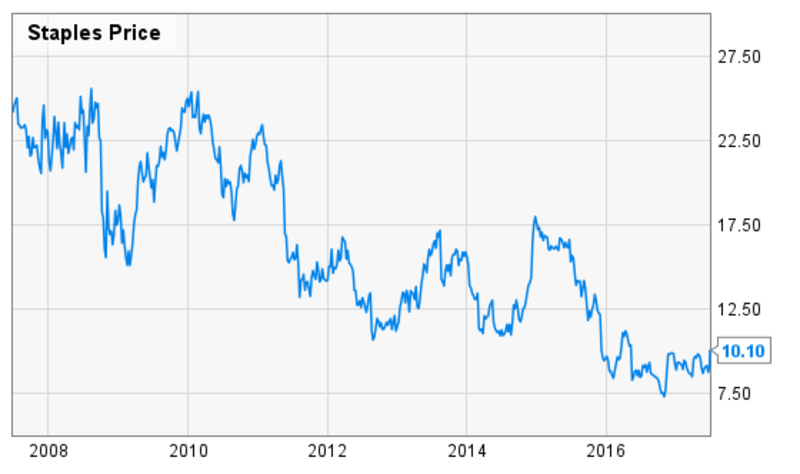
After the M&A deal, Sycamore decided to split the company into three separately financed entities: U.S. retail, Canadian retail, and corporate-supply businesses. The three groups were to remain under the same corporate umbrella. Sycamore’s structured acquisition of Staples was the strongest indication that it would eventually wind down Staples’ weaker retail operations.
Sycamore Partners, with $3.5 billion in capital under management, is a private equity firm based in New York specializing in consumer and retail investments. Whatever it does with Staples, Sycamore may have a hard time returning the company to the public markets. Investors who have lost faith in Staples would need a drastic change in perspective to buy shares in the same company a few years after. Instead, Sycamore may try to sell Staples to a different private equity firm, or a strategic buyer like Walmart.
Lessons for The Brick-And-Mortar: Where Did Staples Go Wrong?
1. Staples’ strategic position began to erode when it moved away from an EDLP value strategy toward one reliant on widest range and convenient locations. New competitors, both digital (Amazon) and brick and mortar (Walmart), eventually were able to claim price leadership—which became critical in the recessionary economy.
2. When your historical competition is weakening, you might overestimate the strength of your own competitive position. As the recession worsened, Staples’ results were bolstered by the problems at Office Depot and OfficeMax.
3. Like the department stores, Staples tried to serve different segments of the market with a “one size fits all” strategy. This created opportunities for specialist competitors or broadline competitors with differentiated strategies (Amazon Business/Amazon Prime/Amazon).
4. Staples gave up on stores, despite having over 2,000 locations. The lack of investment and the reductions in merchandise width and depth discouraged customers and employees. The hi-low pricing with rebates through the loyalty program made it hard to figure out price/value. Customer service worsened, reinforcing this downward spiral.
5. Staples’ 2012 shift toward general merchandise worsened its competitive position—the U.S. market did not need or want another general merchant trying to offer convenience. This was especially true given Staples’ hi-low pricing and constant promotions.
6. Staples’ decision to acquire Office Depot was a complete reversal of the actions the company had taken in the prior three years. While the prior strategy might be questioned, the sudden reversal suggests that senior management was not invested in either the old or the new plan.
7. If you don’t have a strategy, someone will give you one. In recent years, private-equity groups have increasingly stepped in to force strategic decisions that too often are focused on short-term financial gain. In the office-supply industry, Starboard Value played a key role by taking investments in both Office Depot and Staples, and then agitating for deals. In some cases (like the Office Depot-OfficeMax merger), negotiations between private-equity groups can drive deal-making.
8. Acquisitions often become the default strategy. Yet acquisition strategy remains one of the least developed skills in retailing. In the office-supply industry, deals were repeatedly done at extreme premiums and worsened by a reliance on debt financing. This is especially problematic when the merging companies are experiencing weakening performance and are seeking consolidation.
Good News: There’s Still A Way for Physical Retailers Just Like Staples
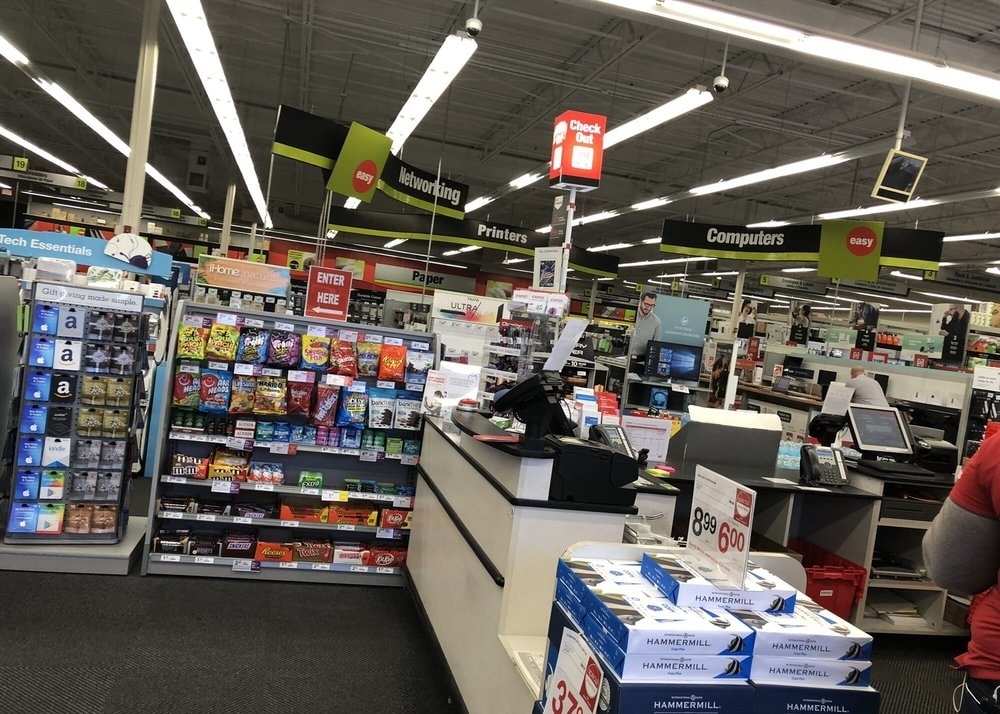
The e-commerce industry appears to be outgrowing brick-and-mortar, yet despite the difference in pacing, physical stores continue to dominate in terms of actual sales. According to U.S. Department of Commerce data, e-commerce sales made up 16% of total U.S. retail spending in 2019. Even if online sellers continue their rapid expansion, physical retailers could maintain control of the market for years to come.
The Answer Is: Specialize In-Store Experience
Brick-and-mortar locations enjoy several advantages that could put a ceiling on the potential of online-only businesses. Physical stores house employees who can talk to customers, and they allow customers to put their hands directly on products and work out issues in real-time.
Young people may love their digital options, but they also love unique experiences and human connections. They may be happy to buy from local stores, especially if they can tag themselves on social media or treat the opportunity as more than a transaction! To capitalize on this opportunity, retailers should focus on creating in-store experiences that inspire customers to keep coming back.
If brick-and-mortar retailers were truly dying, digital brands like Warby Parker, Casper, and Amazon would not have spent money acquiring desirable locations for their physical stores. After several painful lessons in the past, Staples is now thinking outside the box with a new store format which highlights podcasting, community events, and coworking spaces. The Staples Connect concept, which was officially introduced in early 2020, offers experiences and solutions as well as a place to transact.
“We recognize that the way people shop is changing, and with the launch of Staples Connect we are adapting to fit the needs of our customers,” said Mike Motz, Chief Executive Officer, Staples US Retail. “Our customers are teachers, students of all ages, small business owners and side hustlers. Research shows that much of what they are seeking is real human interaction with members of their community and industry, which is key to productivity and growth. At Staples Connect, we do more than just supply your success through product offerings, we wholeheartedly support it.”
This is a gesture to anti-commoditization, a moving away from pushing “product” and toward creating “solutions,” a higher-level calling. Whether the new approach will succeed depends on how well the enlightened Staples connects with its consumers. Attention to detail, shareable moments, personalization, and unique value offerings have so far defined the best in-store experiences, but the smartest retailers will continue to challenge the status quo to see how they can delight customers in new and unexpected ways.









